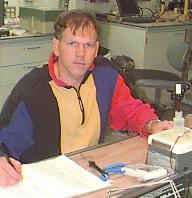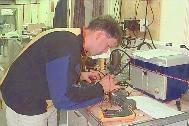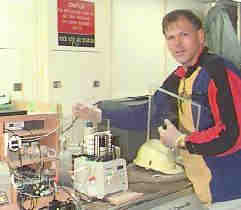| |
Science
Report:
While the previous
science reports have come from Dr. Edward Baker, this report is comes
from Dr. Joseph Resing.
If you've read the previous
reports, I think Ed has done a good job of touching on many of the aspects
that go into what happens on an oceanographic research vessel and more
particularly into what happens during our cruises to study underwater
volcanoes. He mentioned for instance that the ship is going 24 hours a
day seven days a week. Well, as fate would have it, I am on the midnight
to noon watch. About three or four days ago, my body finally adjusted.
As I write this report it is 1:00pm and I am getting ready for bed.
I am an ocean chemist and
when I take water from the hydrocasts that Ed mentioned, I look for chemical
clues that will tell me about the volcano. I measure Fe and Mn, which
are leached out of the solid lava. I also measure pH. Differences in pH
tell me how much carbon dioxide gas is coming out of the volcanoes. When
I combine these chemical clues with other physical measurements, I get
a very good idea about the magmatic state of the volcano. So far my measurements
show a large decrease in the gas content of the fluids from Axial Volcano.
This is consistent with the continued decay of volcanic emissions following
the eruption of axial in February of 1998.
To make these measurements
I use a shipboard chemical analyzer (in the second picture, I am placing
a new sample into the instrument) to measure Fe and Mn, and a pH meter
to measure pH . I also operate an instrument that will measure Fe, Mn,
and pH under water. I place the instrument onto the CTD package and as
it is pulled through the water as Ed described I obtain a picture of the
distribution of these chemicals above the volcano. This instrument is
an in situ chemical analyzer, I like to refer to it as the Vents In Situ
Analyzer (VISA, it's every where you want to be). In the picture, I am
trying to repair the instrument's pump. With help from shore-based engineers,
I am making some progress.
|
|

Joe Resing logging measurements after analyzing the samples.

Joe placing a new sample into the chemical analyzer.

Joe repairing the pump
on VISA (Vents In Situ Analyzer).
|
|

